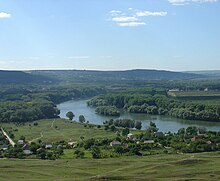


Moldova is an agrarian-industrial state, with agricultural land occupying 2,499,000 hectares in a total area of 3,384,600 hectares.[1] It is estimated that 1,810,500 of these hectares are arable.[1] Moldova is located in Eastern Europe, and is landlocked, bordering Romania and Ukraine.[2] Moldova's agricultural sector benefits from a geographical proximity to large markets, namely the European Union.[1] As a share of GDP, agriculture has declined from 56% in 1995 to 13.8% in 2013.[3] Data from 2015 estimated that agriculture accounted for 12% of Moldova's GDP.[4] Agriculture as a sector is export-oriented, with the composition of Moldova's total exports containing agriculture and the agri-food sector as a main component.[5] 70% of agri-food exports in 2012 included beverages, edible fruits and nuts, oilseeds, vegetable preparations and cereals.[6] Here, fruits, vegetables and nuts were attributed to 33% of Moldova's exports for 2011–2013.[5] Moldova is also one of the top ten apple exporters in the world. However, because of the long-term emphasis on fruit, vegetables are often imported.[7][8]
The declining share of agriculture in GDP does not extend to national value-added, where the agricultural sector in Moldova has the largest share relative to Central and Eastern European countries, withstanding a low productivity.[4] Moldova's growth corresponds to a declining role of agriculture as a sector, and the rising importance of the services sector, aligning with trends for growth of developing economies.[6]
- ^ a b c Gerciu, Viorel; Rundgren, Gunnar (2017). "The Status and Potential of Organic Agriculture in the Republic of Moldova" (PDF). UN Environment Programme.
- ^ Boehlert, Brent B.; Iglesias, Ana; Neumann, James E.; Srivastava, Jitendra P.; Sutton, William R. (2013-01-01). "Reducing the vulnerability of Moldova's agricultural systems to climate change : impact assessment and adaptation options": 1–151.
{{cite journal}}: Cite journal requires|journal=(help) - ^ Moroz, Victor; Ignat, Anatolie (2015). "External Factors' Impact over the Agricultural Sector of the Republic of Moldova". Scientific Papers Series Management, Economic Engineering in Agriculture and Rural Development. 15 (2): 217–226.
- ^ a b Sarbu, Olga; Cimpoies, Liliana (2018-03-31). "Poverty Reduction in Rural Areas Through Agricultural Development: Evidence from Moldova". The Journal "Agriculture and Forestry". 64 (1). doi:10.17707/AgricultForest.64.1.10.
- ^ a b The World Bank (2015). "Republic of Moldova Trade Study" (PDF). The World Bank.
- ^ a b Government of the Republic of Moldova (2014). "National Strategy on Agriculture and Rural Development for the Period 2014-2020" (PDF). Archived from the original (PDF) on 2022-11-21. Retrieved 2020-05-25.
- ^ "EU-Moldova agriculture programme helps face down COVID-19 economic effect". European Investment Bank. Retrieved 2021-04-20.
- ^ eastfruit (2021-01-14). "Horticulture of Moldova 2020: droughts, frosts, and low prices • EastFruit". EastFruit. Retrieved 2021-04-20.